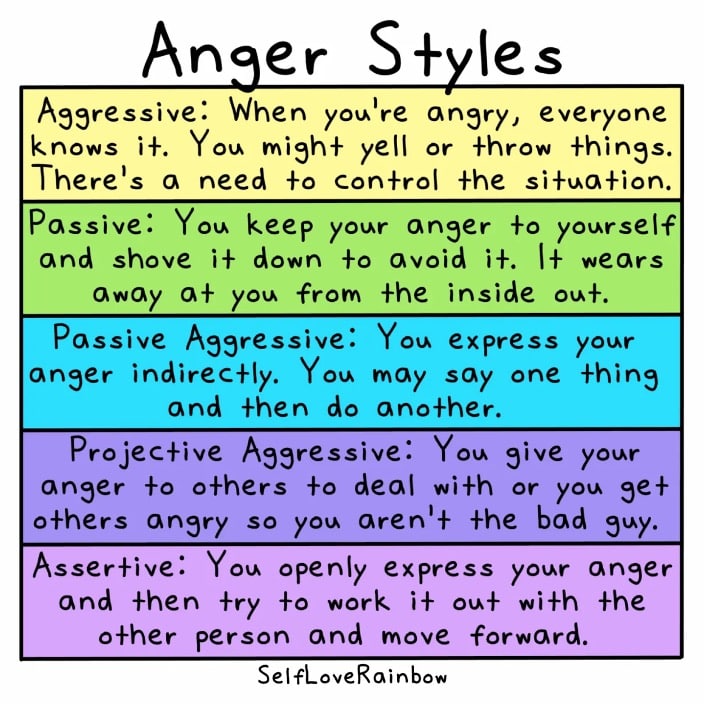Feelings of Anger
Anger
When you think of the feeling of anger what comes to mind? Typically anger is seen as an emotion you should avoid and is stereotyped as “inappropriate”. According to Kassinove, anger “is a negative feeling state that is typically associated with hostile thoughts, physiological arousal and maladaptive behaviors” (2012). Anger can be associated with physical symptoms such as muscle tension, headaches, sweat, or increased heart rate.
Anger Styles
Anger can be conveyed in various ways depending on the situation and the person. There are five styles of anger as shown in this list written by Dominee Calderon.

In this article, the ideal anger style is being assertive which allows individuals to appropriately express their anger with the goal to resolve conflicts. However, anger is typically expressed with an aggressive or passive style.
- Aggressive Style– intimidating or attacking others, screaming, blaming, threatening, humiliating/belittling, aggression towards objects, or engaging in abusive behaviors
- Goal: Win conflict at any costs, gain sense of control of yourself, others, and situations, assure others know that you’re in charge
- Passive Style– repressing or denying anger, putting yourself down, avoid expressing needs and feelings, apologizing for self-expression, refraining from disagreeing with others, letting others take control, sacrificing your needs, and inconveniencing yourself
- Goal: Avoid your own feelings, conflict, confrontation, and hurting/upsetting others
- Passive Aggressive Style– denying personal responsibility for actions or feelings, using sarcasm, giving the silent treatment, mocking someone, holding resentment, withdrawing love/affection/attention, gossiping or tattling, and refusing to cooperate
- Goal: Get your way without taking responsibility and needing to assert yourself
- Projective Aggressive Style– projecting anger onto someone else to get that person to act on or express their anger for you
- Goal: Protect your ego and avoid owning/expressing feelings
- Assertive Style– directly expressing needs, wants, and feelings without blame, accepting different opinions without dismissing them, using a calm tone, taking accountability, and problem-solving
- Goal: Express your needs and feelings, resolve conflict mutually, keep fair boundaries of mutual respect
Advantages & Disadvantages of Anger
| Advantages | Disadvantages |
|---|---|
| Survival: Helps with defending/protecting ourselves and alerting us when we are hurt or threatened | Physical Health: Can increase risk of heart disease, heart attacks, or strokes, weaken immune system, and lower life span |
| Motivation: Provides us with energy to stand against injustice or discrimination and push for change | Mental Health: Can lead to stress, guilt, frustration, irritability, feeling overwhelmed, depression, low self-esteem and an increase in anxiety |
| Control & Optimism: Gives a sense of control and optimism after appropriately expressing anger | Relationships: Can damage your relationships by making it harder for others to trust you, speak honestly or feel comfortable around you. Can also build resentment, unnecessary relation stress, or result in abuse |
| Cooperation: Can lead to better emotional intimacy or cooperation and an increase in respect | Alterations in Judgement: Can make it difficult to think clearly and rationally and may lead to harmful behaviors to cope such as drugs, alcohol, self-harm, etc. |
| Self-Improvement: Being able to address and reflect on anger can lead to spiritual and emotional growth |
Managing Your Anger
Anger can be a beneficial emotion when expressed in a healthy way. Some tips to keep in mind when managing anger are knowing your triggers, recognizing your warning signs, finding appropriate outlets to express anger, engage in calming strategies, and reflect and respond as needed.
- Know your triggers– determine who or what is triggering your anger, understand the reason why that is your trigger, and recognize your reactions to trigger.
- Recognize Warning Signs– identify physical reactions such as sweating, tension in the body, pounding heart, and identify internal reactions such as feeling tense, overwhelmed, easily irritated, out of control, nervous etc.
- Express Anger Appropriately– sit in the feelings of anger and release that energy externally such as crying, safely throwing or breaking appropriate objects, playing video games, or engaging in vigorous exercise.
- Engage in Calming Strategies– engage in activities that promote calmness such as finding a healthy distraction, practicing relaxation exercises for mind and body etc.
- Reflect and Respond To Anger– explore the reasons behind your anger, communicate and express anger to those directly involved, and recognize if you need professional help such as anger management classes or therapy
References:
https://www.selfloverainbow.com/anger-styles-whats-yours/
https://www.apa.org/news/press/releases/2012/05/anger
https://www.apa.org/pubs/books/shame-anger-psychotherapy
https://www.apa.org/topics/anger/understanding
https://www.apa.org/pubs/videos/4310861

